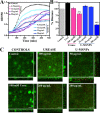Drug-Free Enzyme-Based Bactericidal Nanomotors against Pathogenic Bacteria
- PMID: 33769023
- PMCID: PMC8478280
- DOI: 10.1021/acsami.1c00986
Drug-Free Enzyme-Based Bactericidal Nanomotors against Pathogenic Bacteria
Abstract
The low efficacy of current conventional treatments for bacterial infections increases mortality rates worldwide. To alleviate this global health problem, we propose drug-free enzyme-based nanomotors for the treatment of bacterial urinary-tract infections. We develop nanomotors consisting of mesoporous silica nanoparticles (MSNPs) that were functionalized with either urease (U-MSNPs), lysozyme (L-MSNPs), or urease and lysozyme (M-MSNPs), and use them against nonpathogenic planktonic Escherichia coli. U-MSNPs exhibited the highest bactericidal activity due to biocatalysis of urea into NaHCO3 and NH3, which also propels U-MSNPs. In addition, U-MSNPs in concentrations above 200 μg/mL were capable of successfully reducing 60% of the biofilm biomass of a uropathogenic E. coli strain. This study thus provides a proof-of-concept, demonstrating that enzyme-based nanomotors are capable of fighting infectious diseases. This approach could potentially be extended to other kinds of diseases by selecting appropriate biomolecules.
Keywords: E. coli; biofilms; enzymatic nanomotors; infections; nanomachines; self-propulsion.
Conflict of interest statement
The authors declare no competing financial interest.
Figures





Similar articles
-
Hyaluronic Acid-Based Nanomotors: Crossing Mucosal Barriers to Tackle Antimicrobial Resistance.ACS Appl Mater Interfaces. 2025 May 14;17(19):27988-27999. doi: 10.1021/acsami.5c03636. Epub 2025 Apr 29. ACS Appl Mater Interfaces. 2025. PMID: 40298340 Free PMC article.
-
Natural antimicrobials synergistically coupled with nanomotors: An innovative strategy for biofilm eradication.Food Res Int. 2025 Jul;212:116510. doi: 10.1016/j.foodres.2025.116510. Epub 2025 Apr 22. Food Res Int. 2025. PMID: 40382078
-
Polyethylenimine-mediated synthetic insertion of gold nanoparticles into mesoporous silica nanoparticles for drug loading and biocatalysis.Biointerphases. 2017 Mar 27;12(1):011005. doi: 10.1116/1.4979200. Biointerphases. 2017. PMID: 28347142
-
Mesoporous Silica-Based Materials with Bactericidal Properties.Small. 2019 Jun;15(24):e1900669. doi: 10.1002/smll.201900669. Epub 2019 Apr 29. Small. 2019. PMID: 31033214 Review.
-
A systematic review and meta-analysis of antibiotic resistance patterns, and the correlation between biofilm formation with virulence factors in uropathogenic E. coli isolated from urinary tract infections.Microb Pathog. 2020 Jul;144:104196. doi: 10.1016/j.micpath.2020.104196. Epub 2020 Apr 10. Microb Pathog. 2020. PMID: 32283258
Cited by
-
Construction of intelligent moving micro/nanomotors and their applications in biosensing and disease treatment.Theranostics. 2023 May 15;13(9):2993-3020. doi: 10.7150/thno.81845. eCollection 2023. Theranostics. 2023. PMID: 37284438 Free PMC article. Review.
-
Urease-powered micro/nanomotors: Current progress and challenges.J Pharm Anal. 2025 Mar;15(3):101095. doi: 10.1016/j.jpha.2024.101095. Epub 2024 Sep 3. J Pharm Anal. 2025. PMID: 40177066 Free PMC article. Review.
-
Self-Adaptive Flask-like Nanomotors Based on Fe3O4 Nanoparticles to a Physiological pH.Nanomaterials (Basel). 2022 Jun 15;12(12):2049. doi: 10.3390/nano12122049. Nanomaterials (Basel). 2022. PMID: 35745388 Free PMC article.
-
Hyaluronic Acid-Based Nanomotors: Crossing Mucosal Barriers to Tackle Antimicrobial Resistance.ACS Appl Mater Interfaces. 2025 May 14;17(19):27988-27999. doi: 10.1021/acsami.5c03636. Epub 2025 Apr 29. ACS Appl Mater Interfaces. 2025. PMID: 40298340 Free PMC article.
-
Scientific Advances in the Last Decade on the Recovery, Characterization, and Functionality of Bioactive Compounds from the Araticum Fruit (Annona crassiflora Mart.).Plants (Basel). 2023 Apr 3;12(7):1536. doi: 10.3390/plants12071536. Plants (Basel). 2023. PMID: 37050162 Free PMC article. Review.
References
MeSH terms
Substances
LinkOut - more resources
Full Text Sources
Other Literature Sources
Medical
Molecular Biology Databases

